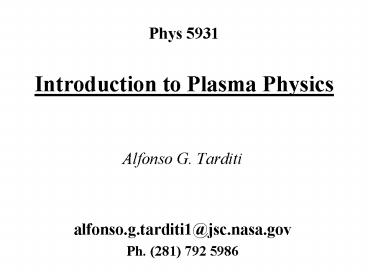Phys 5931 Introduction to Plasma Physics - PowerPoint PPT Presentation
1 / 32
Title:
Phys 5931 Introduction to Plasma Physics
Description:
Magnetic Mirror: charged particles (protons and electrons) move in helical ... Maxwell Equations (minus displacement and charge separation) Continuity Equation ... – PowerPoint PPT presentation
Number of Views:1515
Avg rating:3.0/5.0
Title: Phys 5931 Introduction to Plasma Physics
1
Phys 5931Introduction to Plasma Physics
- Alfonso G. Tarditi
- alfonso.g.tarditi1_at_jsc.nasa.gov
- Ph. (281) 792 5986
2
What you will learn about
3
Fusion Reactions (Deuterium-Tritium)
4
Controlled Fusion Experiments
5
The Tokamak
6
(No Transcript)
7
The Plasma in the Stars
The Sun a very old fusion reactor
8
The Sun-Earth Connection
9
Earth Ionosphere
The Sun
Galactic Cosmic Rays
Ionospheric plasma interactions
Earth Magnetosphere
Detectors on ISS
10
Fusion/Plasma Propulsion
11
Particle motions in Magnetic Fields
- Magnetic Mirror charged particles (protons and
electrons) move in helical orbits at their
cyclotron frequency
12
Fluid Plasma Simulation
13
Particle Simulation
Basic Algorithm Summary
Initial particle loading
Compute interparticle forces
ttDt
Solve particle equation of motion
Update particle positions and velocities
14
(No Transcript)
15
Syllabus
- Object of Plasma Physics
- Plasma Physics Fundamentals
- Applied Plasma Physics theory, simulation and
experiments
16
I. Object of Plasma Physics
- 1. Characterization of the Plasma State
- 1.1 Definition of the Plasma State
- 1.2 Historical Perspective
- 1.3 Transition to the Plasma State
- 1.4 Examples
- 2. Plasmas in Nature
- 2.1 Astrophysical Plasmas
- 2.2 Space Plasma
- 2.3 The Ionosphere
- 3. Plasmas in the Laboratory
- 3.1 Relevance of Plasma Physics in Science and
Technology - 3.2 Nuclear Fusion
- 3.3 Industrial Plasmas
- 3.4 Space Propulsion
17
II. Plasma Physics Fundamentals
- 4. Particle Picture
- 4.1 Unmagnetized Plasmas
- 4.2 Magnetized Plasmas
- 5. The Kinetic Theory
- 5.1 The Distribution Function
- 5.2 Moments of the Plasma Distribution Function
- 6. The Fluidodynamic Description of a Plasma
- 6.1 Fluid Variables
- 6.2 The Fluid Equation of Motion
- 6.3 MHD
- 6.4 Fluid drifts in presence of Magnetic Fields
- 7. Plasma Waves
- 7.1 Dispersion Relation
- 7.2 Classification of Waves in Plasmas
18
III. Applied Plasma Physics theory, simulation,
experiments
- 8. The Plasma Laboratory
- 8.1 Plasma Generation
- - 8.2 Plasma Confinement
- - 8.3 Plasma Heating
- 8.4 Plasma Diagnostic
- 9. Nuclear Fusion
- - 9.1 Inertial Confinement
- - 9.2 Magnetic Confinement
- 9.3 Electrostatic Confinement
- 10. Industrial Plasmas
- 10. 1 Plasma Processing
- 10. 2 Plasma Torches
- 11. Advanced Space Plasma Propulsion
- 11.1 Electric Plasma Propulsion
- 11.2 The VASIMR Experiment
- 12. Space and Astrophysical Plasmas
- 12.1 The Ionosphere
- 12.2 The Stars
- 13.1 Space Plasmas
19
Part I
BACK
- Object of Plasma Physics
20
I. Object of Plasma Physics
- 1. Characterization of the Plasma State
- 2. Plasmas in Nature
- 3. Plasmas in the Laboratory
21
1. Characterization of the Plasma State
BACK
- 1.1 Definition of the Plasma State
- 1.2 Historical Perspective
- 1.3 Transition to the Plasma State
- 1.4 Examples
22
1.1 Definition of the Plasma State
BACK
- 1.1.1 Atomic Physics Brush-Up
- 1.1.2 Ionized Gases
- 1.1.3 From Ionized Gas to Plasma
- 1.1.4 The Fourth State of the Matter
- 1.1.5 Debye Shielding
- 1.1.6 Solid State Plasmas
23
1.1.1 Atomic Physics Brush-Up
BACK
How do atoms really look like?
Atoms in a Silicon crystal as seen through a
Scanning Tunnel Microscope
24
Looking at an Atom
- An electron cloud
25
Looking inside an Atom
- Inside the electron cloud Electrons, Protons
and Neutrons
26
The real proportions inside an atom
27
1.1.2 Ionized Gases
BACK
- An ionized gas is characterized, in general, by a
mixture of neutrals, (positive) ions and
electrons. - For a gas in thermal equilibrium the Saha
equation gives the expected amount of ionization - The Saha equation describes an equilibrium
situation between ionization and (ion-electron)
recombination rates.
28
Example Saha Equation
29
Backup The Boltzmann Equation
The ratio of the number density (in atoms per
m3) of atoms in energy state B to those in
energy state A is given by NB / NA ( gB / gA )
exp -(EB-EA)/kT where the g's are the
statistical weights of each level (the number of
states of that energy). Note for the energy
levels of hydrogen gn 2 n2 which is just the
number of different spin and angular momentum
states that have energy En.
30
1.1.3 From Ionized Gas to Plasma
BACK
- An ionized gas is not necessarily a plasma
- An ionized gas can exhibit a collective
behavior in the interaction among charged
particles - An ionized gas could appear quasineutral if the
charge density fluctuations are contained in a
limited region of space - A plasma is an ionized gas that presents a
collective behavior and is quasineutral
31
1.1.4 The Fourth State of the Matter
BACK
- The matter in ordinary conditions presents
itself in three fundamental states of
aggregation solid, liquid and gas. - These different states are characterized by
different levels of bonding among the molecules. - In general, by increasing the temperature
(average molecular kinetic energy) a phase
transition occurs, from solid, to liquid, to gas.
- A further increase of temperature increases the
collisional rate and then the degree of
ionization of the gas.
32
The Fourth State of the Matter (II)
BACK
- The ionized gas could then become a plasma if the
proper conditions for density, temperature and
characteristic length are met (quasineutrality,
collective behavior). - The plasma state does not exhibit a different
state of aggregation but it is characterized by a
different behavior when subject to
electromagnetic fields.

